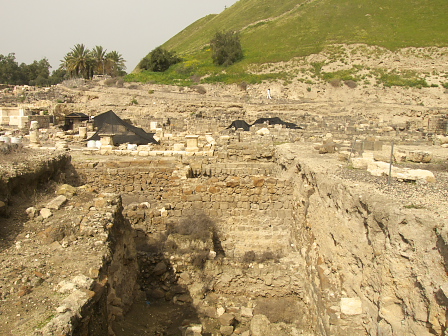|
Excavations at Beit Shean show 15 different civilizations there. The main town is largely Greek and Roman or later. The hill just outside of the Roman town shows older civilizations including some Philistine ruins and an Israeli fortress from the time of Solomon. This city is at a strategic point in the Jezreel Valley and close to a major highway. The city is mentioned in 3900 year old Egyptian documents and appears to be fortified 3500 years ago. The Israelites were unable to conquer the Canaanites in this town until the time of King David. King Solomon made it an administrative center for a region. Under Romans, it became part of a ten city alliance, Decapollis, that stretched east accross the Jordan River. The town was destroyed by a strong earthquake in 749A.D which toppled the columns supporting buildings and roofs along the streets. After being excavated, some columns have been reset. Some reference links: Jewish Magazine and Jewish Virtual Library. |
The ![]() symbol
beside some selected pictures indicates a larger image is available by clicking the symbol.
symbol
beside some selected pictures indicates a larger image is available by clicking the symbol.

|
The amphitheater which started life as a hippodrome for horse and chariot races but apparently was also used for bloody gladiatorial contests as human bones have been found. Only the lowest rows of seating have survived. (This picture was taken from the bus as we passed by.) |

|
The short Northern Street is still littered by columns that have not be reset. Also notice one of the intricate stone carvings that were placed on top of the columns. |

|

|

This is the view of the town from the hill. The theater is at the far end of the Palladius Street and the bathhouse is in front of it on the right. |

Excavations continue at this site. |

|

These are excavations of the Israeli fortress on the hill. |

This picture shows one end of a bridge into the town. It is now called the Broken Bridge. It was built twice, one by Greeks and once by the Romans. |
Return to the main page Recommended
Previous Next
Copyright 2010 James and Danielle Brink. Permission is given for non-commercial use.
Last revision: 4/5/2010